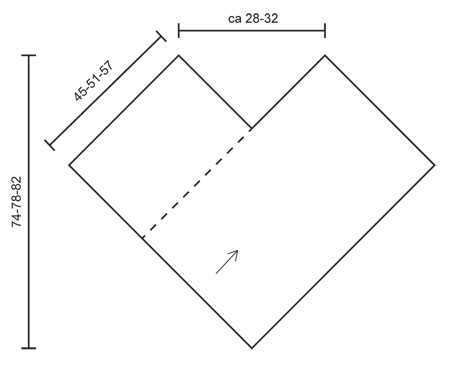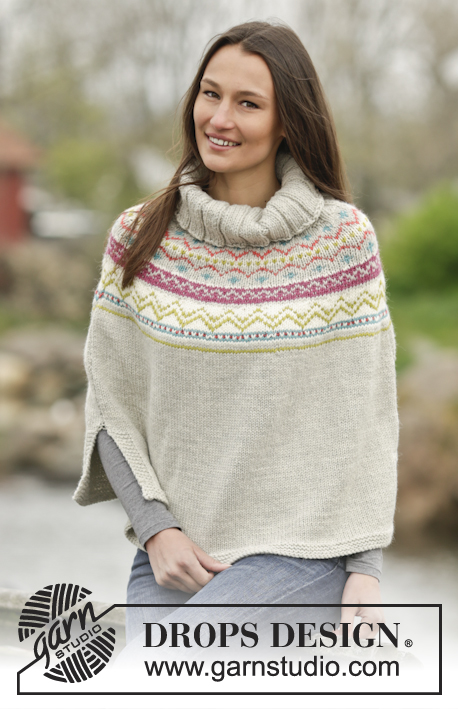Comments / Questions (55)
![]() Lucette wrote:
Lucette wrote:
Bonjour merci de votre réponse pourriez vous me dire à quoi correspond 45.51.57 la largeur du rectangle du tricot et aussi pour le repère à l’assemblage désolée de vous ennuyer je suis débutante Cordialement Lucette
21.11.2024 - 09:25DROPS Design answered:
Bonjour Lucette, les 45-51-57 cm correspondent à la largeur de la bande à tricoter et les 112-121-130 cm à la longueur totale de la bande. Pour toute assistance personnalisée à l'adaptation d'un modèle, merci de bien vouloir contacter votre magasin, même par mail ou téléphone, ou un forum spécialisé. Nous ne sommes malheureusement pas en mesure de pouvoir adapter chacun de nos modèles à chaque demande; merci pour votre compréhension. Bon tricot!
21.11.2024 - 15:32
![]() Lucette wrote:
Lucette wrote:
Bonjour, j’ai fais un échantillon 14 mailles sur 28 rangs et j’ai obtenu que 9 cm de largeur pour le modèle pochon drops 166 30 combien dois je rajouter de mailles pour obtenir une taille xl merci cordialement
20.11.2024 - 18:24DROPS Design answered:
Bonjour Lucette, essayez de nouveau avec des aiguilles plus grosses pour vous rapprocher de la tension recommandée pour ce modèle, à la fois en largeur et en hauteur; ou bien essayez de laver/bloquer votre échantillon pour voir si vous arrivez aux mesures finales ainsi, et du coup vous n'aurez rien à changer. Sinon, il vous faudra recalculer le nombre de mailles nécessaires pour votre taille par rapport à la tension que vous aurez choisie. Bon tricot!
21.11.2024 - 08:39
![]() Frida wrote:
Frida wrote:
Förstår inte riktigt hur man får till det på baksidan-
08.06.2024 - 09:07DROPS Design answered:
Hej Frida, når du syr stykket sammen, som vist på skitsen, vil du få spidsen foran, og et lige stykke bagpå :)
11.06.2024 - 11:47
![]() Anna Vävargård wrote:
Anna Vävargård wrote:
Varför ska man först använda rundstickor och sedan byta till rätstickor?
21.02.2024 - 15:47DROPS Design answered:
Hej Anna, du kan strikke alt på rundpind, hele ponchon stickas i RÄTST (stickas fram och tillbaka): Maskorna stickas räta på alla varv.
22.02.2024 - 11:48
![]() Maartje wrote:
Maartje wrote:
Voormaat L/XL. Ik begrijp het aantal op te zetten steken niet. Als ik 71 steken opzet meet ik 50 cm. Dit is toch veel te weinig? Dit moet toch 1.21 zijn? Dan zou ik toch 168 teken op moeten zetten? Op het patroon mis ik de maat aan de linkerkant, precies de breirichting. super leuke poncho! Graag hoor ik hoeveel steken ik op moet zetten, dus hoeveel cm de breedte moet worden. Hartelijk dank alvast!
06.08.2023 - 16:29DROPS Design answered:
Dag Maartje,
Je breit de poncho in de richting van de pijl (zie tekening onderaan). De afmetingen die je in de maattekening ziet in de schuine aanduiding komen overeen met het de breedte van het werk na het opzetten, dus voor maat L/XL zou dit ongeveer 51 cm moeten zijn.
14.08.2023 - 14:28
![]() Catherine wrote:
Catherine wrote:
I made a swatch and i got 18 stitches for 4 inches. Am i correct that i have to make 124 stitches? I based it on the 27.5 inches neck circumference. Thanks
25.03.2023 - 06:32DROPS Design answered:
Dear Chaterine, changing the gauge will affect the drape and fitting of the finished piece. It would be much better, if you would change the needle size, until you get to the given gauge, and work with that. Happy Crafting!
25.03.2023 - 09:54
![]() Christine wrote:
Christine wrote:
Bonjour Quelle est la largeur du rectangle svp ?
10.01.2023 - 11:40DROPS Design answered:
Bonjour Christine, le rectangle mesure 45-51-57 cm de large (cf schéma des mesures). Bon tricot!
11.01.2023 - 08:53
![]() Polina wrote:
Polina wrote:
Hello! Do I understand right, it should be used three strands simultaneously throughout the whole knitting? If it is, how many g of Brushed Alpaca Silk should be used in total to make the poncho in size L/XL?
15.01.2022 - 10:06DROPS Design answered:
Dear Polina, you can work with either 2 threads of Brushed Alpaca Silk OR 1 thread of Melody. For size L/XL you would need 200 gr of Brushed Alpaca Silk (8 balls) or 200gr of Melody (4 balls). Happy knitting!
16.01.2022 - 21:21
![]() Zuzana wrote:
Zuzana wrote:
Dobrý deň, model som nakoniec uplietla. Na strednú veľkosť som potrebovala 550 g priadze Big Merino. Mám z neho veľkú radosť. Veľmi pomohol váš návod, aj videonávod a tiež dobrá rada. Pri tomto modeli by som uvítala aj obrázok, ako model vyzerá zozadu. Napríklad či zakryje aj kríže.
25.10.2020 - 10:38
![]() Zuzana wrote:
Zuzana wrote:
Dobrý deň, koľko gramov vlny Drops Big Merino budem potrebovať na tento model?
05.09.2020 - 19:53DROPS Design answered:
Dobrý den, Zuzano, na tento model budete potřebovat cca 750-850 g příze Big Merino. Hodně zdaru! Hana
08.09.2020 - 09:27
Lorelei#loreleiponcho |
||||
|
|
||||
Knitted DROPS poncho in garter st with fringes in 2 strands ”Brushed Alpaca Silk” or 1 strand "Melody".
DROPS 166-30 |
||||
|
DOUBLE YARN TIP: Use yarn from both inside and outside of the ball. When switching to a new ball, try to avoid switching both strands at the same time - to avoid a thick yarn when fastening. GARTER ST (back and forth): K all rows. 1 ridge = 2 rows K. FRINGES: Cut 4 lengths of yarn of 36 cm. Fold them double and pull the loop through 1st st in cast-off edge and pull the yarn ends through the loop. Insert a fringe along cast-off edge approx. every 3 cm along the entire edge. Cut fringes to a length of approx. 15 cm. ---------------------------------------------------------- PONCHO: Worked back and forth on needle. READ DOUBLE YARN TIP. Cast on 63-71-80 sts on circular needle size 6 mm with 2 strands Brushed Alpaca Silk or 1 strand Melody. Work in GARTER ST back and forth - see explanation above! REMEMBER THE KNITTING TENSION Continue like this until piece measures 45-51-57 cm. Insert 1 marker in the side of piece, marks where to sew cast-off edge tog with the side. Work in garter st until piece measures 112-121-130 cm. Cast off. ASSEMBLY: Sew with Brushed Alpaca Silk/melody short side (= cast-off edge) tog with long side, from marker and down to cast-on edge. Sew in outer loops of edge sts. Opposite side now forms a tip mid front. Fasten FRINGES - see explanation above, on poncho. |
||||
Diagram explanations |
||||
|
||||

|
||||
Have you finished this pattern?Tag your pictures with #dropspattern #loreleiponcho or submit them to the #dropsfan gallery. Do you need help with this pattern?You'll find 9 tutorial videos, a Comments/Questions area and more by visiting the pattern on garnstudio.com. © 1982-2025 DROPS Design A/S. We reserve all rights. This document, including all its sub-sections, has copyrights. Read more about what you can do with our patterns at the bottom of each pattern on our site. |
||||











































Post a comment to pattern DROPS 166-30
We would love to hear what you have to say about this pattern!
If you want to leave a question, please make sure you select the correct category in the form below, to speed up the answering process. Required fields are marked *.